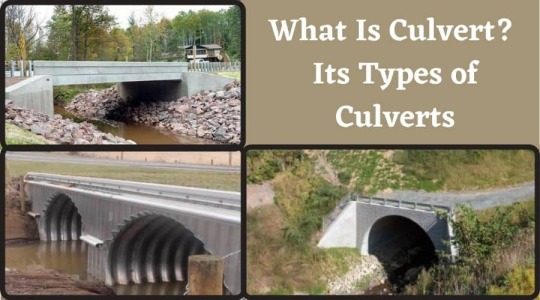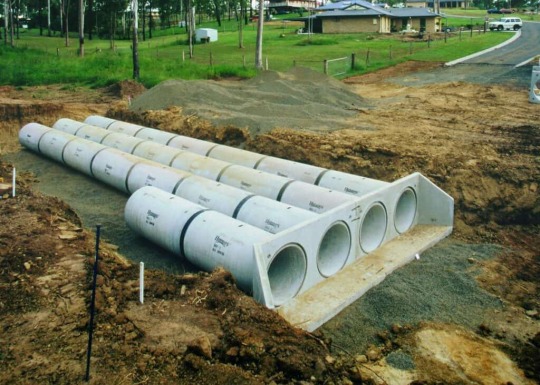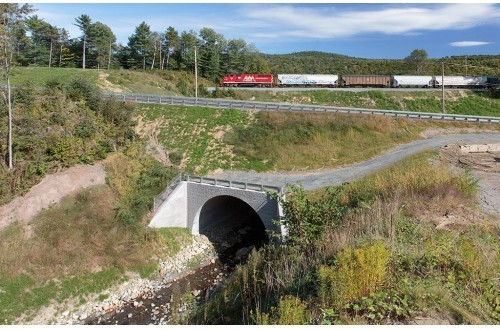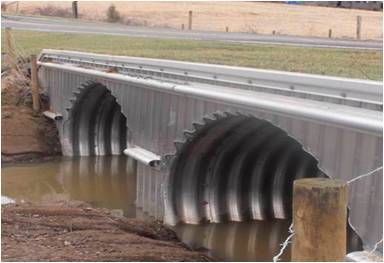#culvertdefinition
Text
Types of Culverts: Pros and Cons of Different Culverts

What Is a Culvert?
Culverts are structures that are built to allow water to flow under a roadway, railway, or other infrastructure.
They come in different shapes and sizes and are made of various materials depending on their purpose and location.
Culverts play a critical role in managing the flow of water in urban and rural areas and are an essential part of any drainage system.
In this article, we will explore the different types of culverts and their applications. We will discuss the advantages and disadvantages of each type, as well as the materials commonly used in their construction.

Culvert
A culvert may also be a bridge or tunnel-like structure designed to allow water, vehicle, and pedestrian traffic to cross over the waterway while allowing adequate passage for the water.
Culvert also acts as a water pipe or sewer that crosses under a road or railway, or trail.
Read More: What Is Plain Cement Concrete (PCC) – Materials, Uses & Grades
Types Of Culvert
There are several types of culverts that are used in construction projects, each with its own unique design and purpose.
- Pipe culvert
- Pipe-arch culvert
- Box culvert
- Arch culvert
- Bridge culvert.
- Metal box culvert
1. Pipe Culvert
The culvert having a single number or multiple pipes are placed side by side over a base of concrete below the embankment of a railway track or roadways by fixing there both ends into masonry walls.
The pipes culvert is made from R.C.C., cast iron, steel, etc. The pipe culverts are widely used, and it is very easy to install at a competitive price.
Pipe culverts are available in different shapes such as circular, elliptical, and pipe arch and their shape selection depends on on-site conditions
These culverts may be used as single in number or multiple, if the width of the span or channel is greater, we will go for multiple pipe culverts.
Generally, they are used for a larger flow, and for an installation of a single pipe culvert, we can use the larger diameter size culvert.
The range diameter of the pipe culvert is between 1 meter to 6m. The pipe culvert is chosen for smaller types of drainage works, which pass through the embankment of roads or railways.

Pipe Culvert
Pipe Culvert Advantages:
- The pipe culvert is constructed for any strength by using proper thickness, reinforcement, and mixed design.
- Pipe culverts are inexpensive.
- The compressive stresses and tensile stresses can easily withhold that type of culvert.
- The water crosses from under the structure.
2. Pipe Arc Culvert
The pipe-arch culvert is a simple structure that looks like a half-circle-shaped culvert. It is suitable for larger waterway openings, but the flow should be stable where fishes can be provided with the greater hydraulic advantage they are artistic and it provides low clearance.

Pipe Arc Culvert
It is easier to install and also it is lightweight in nature. In sites condition, pipe arches are particularly useful where the headroom is limited, and as per the requirement of site condition, that type of culvert can also be provided in multiple numbers.
Such a type of pipe arch culvert is useful to enhance its beautiful appearance.
3. Box Culvert
The culverts are constructed in the form of one or more rectangular or square openings, in their top slabs.
The box culverts are made up of concrete specially R.C.C. materials. They used to dispose of rainwater so, these are not useful in dry periods.
This culvert's construction is preferable, especially in loose soil conditions, and for a larger span and also it requires a good foundation, and not be used for larger velocity.

Box Culvert
For a single span of 3 m or for a double span of 6 m width, such types of culverts can be used. The thickness range of the R.C.C slab should be kept within 1.25 to 2.5 m.
There is a sudden change that occurs in the section of bending moment and shearing force due to the sinking of the culvert. Box culvert is a rigid frame and simple construction.
Pressure on the soil is reduced due to the bottom slab of a culvert. Box culvert is economical due to there is no need to provide a separate foundation and also rigidity.
4. Arc Culvert
The arch culvert involves the construction of a superstructure its superstructure consisting of one or two segmental arches consisting of brick masonry, concrete, or stone masonry is commonly used.
The arch culverts are not provided with piers to the sides of the abutment.

Arc Culvert
Advantages Of Arc Culvert:
- The arch culvert and artificial floors both are made up of concrete.
- The pipe arch culvert and arch culvert are similar but in the case of an arch culvert, an artificial floor is provided below the arch.
- It is normally used for narrow passages.
- The arch culvert is similar to the Masonry bridges.
- The arch culvert is very easy to install.
- The arch culvert is also made of steel but it is very extortionate.
5. Bridge Culvert
A bridge culvert acts as both bridge as well as a culvert. So, it can be term as a multi-purpose culvert.
Generally, it is rectangular but if the presence of an artificial floor is not important it can be replaced by a box culvert.

Bridge Culvert
It is generally constructed on rivers and canals hence; it serves a dual purpose. In the bridge culvert, the foundation is provided under the ground level and pavement is present on top of the culvert series.
The advantages of a bridge culvert are to allow traffic to pass on it, it is the most expensive river crossing, very strong, and has a highly strong foundation.
Read More: Types of Pavement Markings And Their Meanings | Uses
6. Metal Box Culvert

Metal Box culvert
Metal box culvert is an economical alternative to the bridge which is manufactured by using a standard structural plate or deep-corrugated structural plate. Metal box culvert is very easy to install and it is constructed in a short period.
They have a long service life with greater durability.
Shapes And Sizes Of Culverts
Culverts come in many sizes and shapes as follows;
- Round
- Elliptical
- Flat-bottomed
- Open-bottomed
- Pear-shaped
- Box-like constructions
Parts of A Culvert
The major culvert parts are as follows;

Components Of Culvert
- Pavement
- parapet
- Headwall
- Dingwall
- Crown
- Apron
- Road embankment
- Culvert inlet
- Culvert pipe
- Culvert outlet
- Culvert foundation
Importance of Culverts
Culverts play a crucial role in managing the flow of water in both urban and rural areas. They are essential components of any drainage system as they allow water to flow under roads, railways, and other infrastructure without causing damage or disruption to the surface above.
Culverts can also help prevent erosion and flooding by directing water away from areas where it can cause harm.
In addition to their role in managing water flow, culverts also provide a variety of other benefits. For example, they can help maintain the integrity of roads and railways by preventing water damage to the infrastructure above.
Culverts can also provide a habitat for aquatic life, and they can be used to help prevent the spread of invasive species.
Overall, culverts are critical pieces of infrastructure that help ensure the safe and efficient movement of water. Without culverts, many areas would be prone to flooding, erosion, and damage to infrastructure.
Therefore, it is essential to properly design, construct, and maintain culverts to ensure that they continue to function effectively over time.
FAQs:
What are the different types of culverts?There are several types of culverts, including box culverts, pipe culverts, arch culverts, bridge culverts, and more. Each type is designed to meet different engineering and design requirements.What is the difference between box culverts and pipe culverts?Box culverts are rectangular or square-shaped concrete structures that are used to manage large volumes of water. Pipe culverts, on the other hand, are circular or oval-shaped pipes that are used to manage smaller volumes of water.What materials are used to construct culverts?Culverts can be made from a variety of materials, including concrete, steel, aluminum, plastic, and more. The choice of material depends on factors such as the expected lifespan of the culvert, the volume of water that needs to be managed, and the environmental conditions.What are some common applications for culverts?Culverts are commonly used in a variety of applications, including road and railway crossings, drainage systems, and flood control measures. They can also be used to manage water in agricultural and industrial settings.
You Might Also Like:
- Types of Pavement Markings And Their Meanings | Uses
- 25+ Types of Pile Foundations & Their Application
- What Is Plain Cement Concrete (PCC) – Materials, Uses & Grades
- Bridge Components and Their Function
Read the full article
#Archculvert#boxculvert#Boxculvert(singleormultiple)#Bridgeculvert#concreteboxculvert#concreteculvertpipe#culvert#culvertdefinition#defineculvert#Metalboxculvert#Pipeculvert#Pipe-archculvert#shapeofculvert#TypesOfCulvert#whatisaculvert
1 note
·
View note